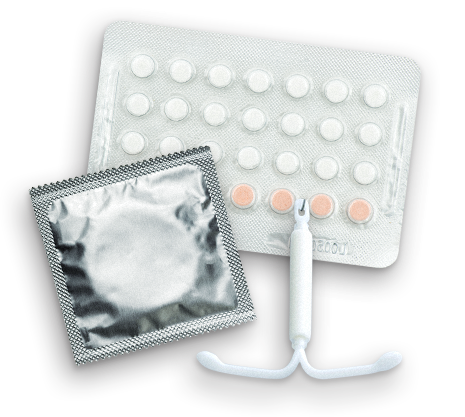There are many methods of birth control. Some prevent pregnancy by stopping the egg from being released (ovulation). Others act as a barrier to prevent sperm from reaching and entering the egg.
Condoms are the only method of birth control that also protect against sexually transmitted infections (STIs). Emergency contraceptive pills (EC) can be used with other methods of birth control if you didn’t use birth control or your birth control method has failed (e.g. the condom broke). Keep reading to learn more about the different kinds of birth control options.
Condom (External)
An external condom is a thin covering that fits over a hard (erect) penis. It decreases the risk of pregnancy by stopping sperm from getting to and entering the egg. It also decreases the risk of STIs and HIV by stopping semen, vaginal fluid, or blood from being passed between partners. Condoms can be used to prevent STIs and pregnancy.
There are many different types of external condoms (styles, shapes, and sizes). Most are latex, but there are non-latex ones. All condoms sold in Canada must meet government standards.
Download an information sheet here.
Condom (Internal)
An internal condom (sometimes called a female or vaginal condom) is a soft, plastic (non-latex) sleeve with two flexible rings, one on each end. The closed, inner ring goes inside the vagina. The outer ring stays outside the vagina to cover the genitals.
It decreases the risk of pregnancy by stopping the sperm from getting to or entering the egg. It reduces the risk of STIs by stopping semen, vaginal fluid, or blood from being passed between sexual partners.
Download an information sheet here.
Intrauterine devices (IUD)
An intrauterine device (IUD) is a small, soft, T-shaped device with a nylon string attached to it. It’s put in the uterus by a health care provider to help prevent pregnancy. There are 2 types of IUDs (copper and hormonal). Depending on the type of IUD, it can help prevent pregnancy for 3 to 10 years.
Download an information sheet here.
Birth Control Pill
The pill is taken every day to prevent pregnancy. It contains estrogen and progestin that stops the ovaries from releasing an egg. You can’t become pregnant if you don’t release an egg.
Download an information sheet here.
Birth Control Patch
The birth control patch is a thin, light brown patch that you wear on your skin. It has to be changed once a week. The sticky part contains hormones (estrogen and progestin) that are absorbed through the skin. They stop the ovaries from releasing an egg. You can’t become pregnant if you don’t release an egg.
Download an information sheet here.
Birth Control Ring
The birth control ring is a soft, 5.5 cm (2 inch), clear, plastic (non-latex) ring that you put in your vagina around the cervix once a month and is left inside for 3 weeks at a time. It contains hormones (estrogen and progestin) that stop the ovaries from releasing an egg. You can’t become pregnant if you don’t release an egg.
Download an information sheet here
Hormonal Birth Control – Extended and Continuous Use
Extended use is when you take your birth control product for 2 or more cycles without stopping, then take a planned break from the birth control pills that have hormones in them. You’ll have your period during this break. This method means that you’ll have fewer periods.
Continuous use is when you take your birth control product without stopping (without taking planned breaks). You’ll have fewer or no periods.
Download an information sheet here.
Progestin-Only Pill (POP)
Progestin-Only Pill (POP), also called the mini-pill, is a pill you take every day to prevent pregnancy. POP contains one hormone (progestin). It doesn’t contain estrogen. POP prevents pregnancy by decreasing the cervical mucous and making it thicker, slowing down the egg in the fallopian tube, and sometimes stopping an egg from being released.
Download an information sheet here
Birth Control Injection
The birth control injection contains a hormone (progestin). It doesn’t contain estrogen. The hormone stops your body from releasing an egg, makes the lining of the uterus thin, and makes cervical mucous thick. You need a prescription for the injection. It needs to be given by a health care provider every 10 to 12 weeks.
Download an information sheet here.
Spermicides
Spermicides are put in the vagina before sex to help prevent pregnancy. They contain an ingredient called nonoxynol-9 that kills sperm. In Canada, spermicides come as film (a small square of clear film that turns into a gel once it’s inside the vagina) or foam. Spermicidal gel is no longer available in Canada but is available in other countries. Spermicides are one of the least effective methods of birth control. They are better at preventing pregnancy when used with another method of birth control such as condoms or diaphragms.
Download an information sheet here
Implant
The birth control implant is a thin, plastic rod about 4 cm long that contains a hormone (progestin), like the hormone that ovaries produce. The hormone stops the body from releasing an egg. It also makes cervical mucous thicker, so it’s harder for sperm to pass through. A prescription is needed for the implant, and a healthcare provider inserts it. The implant can stay in for up to 3 years.
Download an information sheet here
Diaphragm
A diaphragm is a barrier method of birth control that is put in the vagina before having vaginal sex to prevent pregnancy. It is a disc-shaped cup with a flexible rim that can be made of latex, silicone, or nylon. It covers the cervix and stops sperm from entering the uterus.
Download an information sheet here
Fertility Awareness-Based (FAB) Methods
Fertility Awareness-Based (FAB) methods, sometimes called natural family planning, identifies the time during the menstrual cycle when ovulation is happening and pregnancy is most likely to happen. This can be used to:
- prevent pregnancy—don’t have vaginal sex or use a barrier method of birth control around the time of ovulation. While there may be advantages to this method of birth control, it is also the least effective way of preventing pregnancy.
- become pregnant—have vaginal sex during the most fertile time around ovulation.
Download an information sheet here.
Lactation Amenorrhea Method (LAM) used after the birth of a baby
LAM is a type of birth control that uses the hormones your body makes while breastfeeding to help prevent pregnancy. Breastfeeding (lactation) hormones send a signal to your ovaries to stop releasing eggs and stop having periods (amenorrhea). If you don’t release an egg, you can’t get pregnant.
It’s still possible to get pregnant while breastfeeding. For LAM to be successful, all three of the following need to be true:
- It must be less than 6 months since you gave birth.
- You are fully breastfeeding your baby (baby gets no other liquids or food) or nearly-fully breastfeeding your baby (baby gets occasional vitamins, water, or other liquids that do not lower the number of feedings) both day and night.
- Your period has not returned. This means you have not had vaginal bleeding for 2 or more days in a row (not including post-partum bleeding during the first 6 weeks after giving birth).
After pregnancy, your body will release an egg (ovulate) before your period returns so you may not have warning that fertility has returned. Carefully following this method is the only way to reduce the risk of a pregnancy too soon after birth. This is why you need to have all three of the conditions described above for LAM to work.
Download an information sheet here.
Emergency Contraception (EC)
You can use emergency contraception (EC) if you aren’t sure if you’re protected from pregnancy (e.g., condom breaks, forgot birth control, or no method of birth control was used). EC should be used as soon as possible after vaginal sex without a condom or method of birth control. EC doesn’t protect against STIs and HIV. The two methods of EC are emergency contraception pills (ECPs), and the copper intrauterine device (IUD).
Download an information sheet here.
Tubal Ligation
A tubal ligation is a permanent method of birth control. Surgery is done to close the fallopian tubes (the tubes that the egg travels through). This stops the egg and sperm from meeting. If the sperm can’t reach and enter the egg, you can’t become pregnant.
Download an information sheet here.
Vasectomy
A vasectomy is a permanent form of birth control. The tubes (vas deferens) that carry the sperm from the testicles into the semen are partially removed or blocked. Without sperm a person can’t get pregnant.
Download an information sheet here.
Pulling Out (Withdrawal)
Pulling out is when the penis is pulled out of the vagina before ejaculation. It is used during vaginal sex to reduce the risk of pregnancy. A person must not ejaculate (cum) near the genitals because pregnancy can happen if sperm gets in the opening of the vagina. It is also sometimes called the withdrawal method.
Download an information sheet here.
Abstinence
Abstinence means choosing not to do something. It can mean different things to different people. Abstinence means choosing not to have sex, and includes not engaging in:
- direct touching of partners’ genitals
- vaginal sex (penis to vagina)
- anal sex (penis to anus)
- oral sex (mouth to penis, anus, or vulva/vagina)
You can’t get pregnant if you are abstinent from vaginal sex (no genital contact between a penis and vagina). There is a chance of pregnancy if sperm is near the opening of the vagina. The only way to prevent STIs and HIV is to abstain from any activity that involves sexual contact between one person’s body and another person’s genital area, semen, vaginal fluid or blood.
Download an information sheet here

 Birth Control Pill
Birth Control Pill
 Birth Control Injection
Birth Control Injection
 External Condom
External Condom
 Emergency Contraception
Emergency Contraception
 Birth Control Patch
Birth Control Patch
 IUD
IUD
 Diaphragm
Diaphragm
 Birth Control Ring
Birth Control Ring



